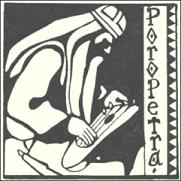
Poropetra - "Poropetra"
(Rautajouhi / 2005)

The
Finnish folk band „Poropetra“ has sent their first CD production to Sheol
Magazine, so of course it was a joy to review it. (Okay, I wouldn´t review any
Pop- or Rock- music CDs, but for pure Finnish folk music I will do an exception.)
It
is possible that you know one member of this band (“Hittavainen”) from the
Finnish folk-metal band “Korpiklaani”, and maybe you know another member
(“Frostheim”) from the Moonsorrow album “Verisäkeet” on which he plays
Kantele (the traditional Finnish instrument) in the song “Jotunheim”. So,
you see, here we have a union of very skilled Finnish musicians, which do it
RIGHT, if they make folk music.
The
whole album consists of 5 longer pieces in mostly Finnish language (which sounds
really great if it´s sung), except for one song (“Saare Piiga”, which is in
Estonian language).
The
first song „Tunturikikka“ starts off slightly
lively and lovely with
guitar- and flute- sounds, but it´s also filled with a hidden yearning, which
is covered in the singing and the minor-tones. Somehow that´s how I always
imagined Finnish folk music to be like, and that´s how it surprisingly really
is. Here
you also get confronted with the very rough and origin singing voice of the
vocalist Virva Holtiton. So, don´t expect some clear bird-like singing, but do
expect a real Finnish raw man’s voice in the baritone-pitched-area, which also
is shaking a bit during the longer tones. But
maybe that`s part of what makes the album sound so absolutely origin and
folk-like… giving you a feeling of sitting in a Finnish forest at the campfire
whilst some young men are spreading magic with their handmade music.
The second track „Västäräkki“ is a quite wild, melodic, very tempestuous,
instrumental-only piece, in which you clearly hear some of all those Finnish
traditional instruments. On this album the band uses instruments like for
instance 10-string
kantele, shaman drum, mouth harp, percussions, violin, jouhikko, torupill,
mandoline, pipes or mouth harp (for more informations about these instruments
you can read my interview with Poropetra in the interviews section).
The
third song „Salon Sahti“ starts with throat-singing,
which sounds a bit like the bellowing of stags and demands great voice-technical
knowledge, otherwise you will ruin your voice with it. The same kind of
throat-singing can be heared in the background throughout the whole song, whilst
in the foreground you hear singing in harmony by men’s voices, supported by
very folky melodies, which are extremely catchy and make you wanna spend your
next holiday in a Finnish village. And the flutes and some other seldom
instruments dance around your senses easy-free and animating, spreading a good
mood.
„Saare piiga“, the song in Estonian language, is next on the album. I have
to admit that the Finnish language sounds nicer to my German ears than the
Estonian, yet alone because of the “R”s, like only the Finns can pronounce
it. But melodically the song is on the same level of quality like the other ones,
which also includes the longing, heart-felt mood in the lyrics.
„Tuulikannel“ softly leads you out of the album. You can hear Frostheim
humming (instead of any singing vocals) und it gets really melancholical and
yearning once more, impressingly transferred by the hummed melodies and the sad
violin tones in a minor. You just get pulled into the sentimental atmosphere of
the song without having a chance to escape.
So those Finns of Poropetra really deserve the highest praise for this music.
They just know how to produce good folk music!
Score: 8 out of 10 points.
Review by Twilightheart
As
I find this whole topic very interesting (all those Finnish instruments, which
are a total new experience for me to listen to) I used the chance to make an
interview with band-founder Virva Holtiton to get an explaination about all the
origin instruments, which are used on this album, and also in general to get to
know more about this band (and what the word “Poropetra” actually means
anyway) and to talk about the Finns and their music in general.
Click
HERE to read the interview!